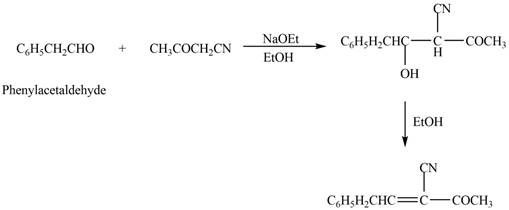
Concept explainers
Draw the products formed in the crossed aldol reaction of phenylacetaldehyde
(a)
Interpretation: The product that is formed in the given crossed aldol reaction of phenylacetaldehyde
Concept introduction: The crossed aldol reaction takes place between the two different carbonyl compounds that is between two different aldehydes or two different ketones or one aldehyde and one ketone. The crossed aldol reaction takes place only if the carbonyl compound contains an acidic
Answer to Problem 24.8P
The product that is formed in the given crossed aldol reaction of phenylacetaldehyde
![]()
Explanation of Solution
The product that is formed in the given crossed aldol reaction is shown below.

Figure 1
In this crossed aldol reaction, phenylacetaldehyde reacts with
The product that is formed in the given crossed aldol reaction of phenylacetaldehyde
(b)
Interpretation: The product that is formed in the given crossed aldol reaction of phenylacetaldehyde
Concept introduction: The crossed aldol reaction takes place between the two different carbonyl compounds that is between two different aldehydes or two different ketones or one aldehyde and one ketone. The crossed aldol reaction takes place only if the carbonyl compound contains an acidic
Answer to Problem 24.8P
The product that is formed in the given crossed aldol reaction of phenylacetaldehyde
![]()
Explanation of Solution
The product that is formed in the given crossed aldol reaction is shown below.

Figure 2
In this crossed aldol reaction, phenylacetaldehyde reacts with
The product that is formed in the given crossed aldol reaction of phenylacetaldehyde
(c)
Interpretation: The product that is formed in the given crossed aldol reaction of phenylacetaldehyde
Concept introduction: The crossed aldol reaction takes place between the two different carbonyl compounds that is between two different aldehydes or two different ketones or one aldehyde and one ketone. The crossed aldol reaction takes place only if the carbonyl compound contains an acidic
Answer to Problem 24.8P
The product that is formed in the given crossed aldol reaction of phenylacetaldehyde

Explanation of Solution
The product that is formed in the given crossed aldol reaction is shown below.

Figure 3
In this crossed aldol reaction, phenylacetaldehyde reacts with
The product that is formed in the given crossed aldol reaction of phenylacetaldehyde
Want to see more full solutions like this?
Chapter 24 Solutions
Package: Loose Leaf for Organic Chemistry with Biological Topics with Connect Access Card
- Don't used Ai solutionarrow_forwardLet's see if you caught the essentials of the animation. What is the valence value of carbon? a) 4 b) 2 c) 8 d) 6arrow_forwardA laser emits a line at 632.8 nm. If the cavity is 12 cm long, how many modes oscillate in the cavity? How long does it take for the radiation to travel the entire cavity? What is the frequency difference between 2 consecutive modes?(refractive index of the medium n = 1).arrow_forward
- A laser emits a line at 632.8 nm. If the cavity is 12 cm long, how many modes oscillate in the cavity? How long does it take for the radiation to travel the entire cavity? What is the frequency difference between 2 consecutive modes?(refractive index of the medium n = 1).arrow_forwardThe number of microstates corresponding to each macrostate is given by N. The dominant macrostate or configuration of a system is the macrostate with the greatest weight W. Are both statements correct?arrow_forwardFor the single step reaction: A + B → 2C + 25 kJ If the activation energy for this reaction is 35.8 kJ, sketch an energy vs. reaction coordinate diagram for this reaction. Be sure to label the following on your diagram: each of the axes, reactant compounds and product compounds, enthalpy of reaction, activation energy of the forward reaction with the correct value, activation energy of the backwards reaction with the correct value and the transition state. In the same sketch you drew, after the addition of a homogeneous catalyst, show how it would change the graph. Label any new line "catalyst" and label any new activation energy.arrow_forward
 ChemistryChemistryISBN:9781305957404Author:Steven S. Zumdahl, Susan A. Zumdahl, Donald J. DeCostePublisher:Cengage Learning
ChemistryChemistryISBN:9781305957404Author:Steven S. Zumdahl, Susan A. Zumdahl, Donald J. DeCostePublisher:Cengage Learning ChemistryChemistryISBN:9781259911156Author:Raymond Chang Dr., Jason Overby ProfessorPublisher:McGraw-Hill Education
ChemistryChemistryISBN:9781259911156Author:Raymond Chang Dr., Jason Overby ProfessorPublisher:McGraw-Hill Education Principles of Instrumental AnalysisChemistryISBN:9781305577213Author:Douglas A. Skoog, F. James Holler, Stanley R. CrouchPublisher:Cengage Learning
Principles of Instrumental AnalysisChemistryISBN:9781305577213Author:Douglas A. Skoog, F. James Holler, Stanley R. CrouchPublisher:Cengage Learning Organic ChemistryChemistryISBN:9780078021558Author:Janice Gorzynski Smith Dr.Publisher:McGraw-Hill Education
Organic ChemistryChemistryISBN:9780078021558Author:Janice Gorzynski Smith Dr.Publisher:McGraw-Hill Education Chemistry: Principles and ReactionsChemistryISBN:9781305079373Author:William L. Masterton, Cecile N. HurleyPublisher:Cengage Learning
Chemistry: Principles and ReactionsChemistryISBN:9781305079373Author:William L. Masterton, Cecile N. HurleyPublisher:Cengage Learning Elementary Principles of Chemical Processes, Bind...ChemistryISBN:9781118431221Author:Richard M. Felder, Ronald W. Rousseau, Lisa G. BullardPublisher:WILEY
Elementary Principles of Chemical Processes, Bind...ChemistryISBN:9781118431221Author:Richard M. Felder, Ronald W. Rousseau, Lisa G. BullardPublisher:WILEY





